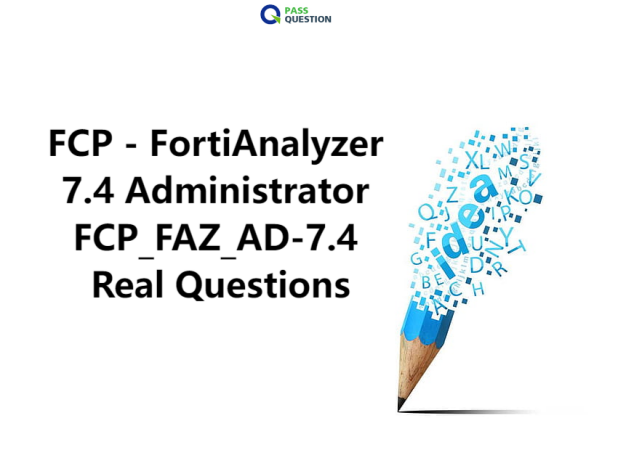FCP - FortiAnalyzer 7.4 Administrator FCP_FAZ_AD-7.4 Real Questions
The FCP_FAZ_AD-7.4 FCP - FortiAnalyzer 7.4 Administrator exam stands out as one of the highly sought-after elective examinations within the FCP in the Network Security Certification program. Recognizing the importance of thorough preparation, PassQuestion has developed and curated a comprehensive set of the most up-to-date FCP - FortiAnalyzer 7.4 Administrator FCP_FAZ_AD-7.4 Real Questions which are designed to closely simulate the actual exam environment, providing candidates with an invaluable resource to hone their skills and knowledge. By leveraging these FCP - FortiAnalyzer 7.4 Administrator FCP_FAZ_AD-7.4 Real Questions, aspiring administrators can gain the confidence and expertise necessary to achieve certification with greater ease successfully.

FCP_FAZ_AD-7.4 FCP - FortiAnalyzer 7.4 Administrator
The FCP - FortiAnalyzer 7.4 Administrator exam evaluates your knowledge of and expertise with FortiAnalyzer. The exam tests applied knowledge of FortiAnalyzer configuration, operation, and day-to-day administration, and includes operational scenarios, system configuration, device registration, and troubleshooting. The FCP - FortiAnalyzer 7.4 Administrator exam is intended for network and security analysts responsible for the configuration and administration of FortiAnalyzer solutions for centralized logging and reporting. This exam is part of the Fortinet Certified Professional - Network Security certification track. This certification validates your ability to secure networks and applications by deploying, managing, and monitoring Fortinet network security products.
Exam Information
Exam Name: FCP - FortiAnalyzer 7.4 Administrator
Exam series: FCP_FAZ_AD-7.4
Time allowed: 65 minutes
Exam questions: 35 multiple-choice questions
Scoring Pass or fail. A score report is available from your Pearson VUE account.
Language: English, Japanese, and French
Product version: FortiAnalyzer 7.4.1, FortiOS 7.4.1
Fortinet FCP_FAZ_AD-7.4 Exam Objectives
Successful candidates have applied knowledge and skills in the following areas and tasks:
System configuration
- Perform initial configuration
- Manage high availability
- Manage RAID
- Describe FortiAnalyzer concepts
Device management
- Manage devices
- Troubleshoot device communication issues
Logs and reports management
- Manage log data
- Manage reports
Administration
- Configure administrative access
- Manage administrative domains (ADOMs)
- Manage disk quota and backups
View Online FCP - FortiAnalyzer 7.4 Administrator FCP_FAZ_AD-7.4 Free Questions
1. You finished registering a FortiGate device. After traffic starts to flow through FortiGate. you notice that only some of the logs expected are being received on FortiAnalyzer.
What could be the reason for the logs not arriving on FortiAnalyzer?
A. This FortiGate is part of an HA cluster but it is the secondary device.
B. This FortiGate model is not fully supported.
C. FortiGate does not have logging configured correctly.
D. FortiGate was added to the wrong ADOM type.
Answer: C
2. What is the purpose of using prefilters when configuring event handlers?
A. They limit which logs are checked for matches by the other filters.
B. They can filter the logs before they are processed by FortiAnalyzer
C. They download new filters to be used in event handlers.
D. They are common filters applied simultaneously to all event handlers.
Answer: A
3. FortiAnalyzer uses the Optimized Fabric Transfer Protocok (OFTP) over SSL for what purpose?
A. To upload logs to an SFTP server
B. To prevent log modification during backup
C. To send an identical set of logs to a second logging server
D. To encrypt log communication between devices
Answer: D
4. What must you configure on FortiAnalyzer to upload a FortiAnalyzer report to a supported external server? (Choose two.)
A. SFTP, FTP, or SCP server
B. Mail server
C. Output profile
D. Report scheduling
Answer: A,C
5. Which item must you configure on FortiAnalyzer to email generated reports automatically?
A. Output profile
B. Report scheduling
C. SFTP server
D. SNMP server
Answer: A
6. For which two purposes would you use the command set log checksum? (Choose two.)
A. To help protect against man-in-the-middle attacks during log upload from FortiAnalyzer to an SFTP server.
B. To prevent log modification or tampering.
C. To encrypt log communications.
D. To send an identical set of logs to a second logging server.
Answer: A,B
7. Which log type does the FortiAnalyzer indicators of compromise feature use to identify infected hosts?
A. Antivirus logs
B. Web filter logs
C. IPS logs
D. Application control logs
Answer: B
8. Which FortiAnalyzer command erases all device settings, images, databases, and logs on disk, but preserves The network configuration?
A. execute reset all-except-ip
B. execute factory-reset
C. execute format disk
D. execute formatlogdisk
Answer: A
9. What is the best approach to handle a hard disk failure on a FortiAnalyzer that supports hardware RAID?
A. There is no need to do anything because the disk will self-recover.
B. Run execute format disk to format and restart the FortiAnalyzer device.
C. Perform a hot swap of the disk.
D. Shul down FortiAnalyzer and replace the disk.
Answer: C
10. Which two of the available registration methods place the device automatically in its assigned ADOM? (Choose two.)
A. Serial number
B. Pre-shared key
C. Request from the device
D. Fabric Authorization
Answer: C